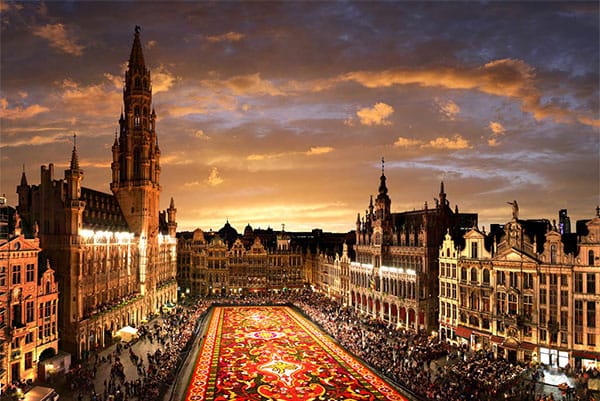
Brussels is one of the oldest and most beautiful cities in Europe. That ancient charm often and unfortunately comes at the cost of wheelchair accessibility. As someone who has visited Brussels on numerous occasions, I’m excited to share with you where and how to find access in the city that is truly the Capital of Europe.
Although some of the popular things to do are riddled with barriers, you’ll still be able to enjoy the city’s main square, go to the top of the Atomium and giggle at the sight of Manneken Pis. Use this guide to make the most of your time in Brussels, Belgium.
Grand Place (Grote Markt)
The Central Square in the City of Brussels, the Grand Place that stands today can trace its history to 1401, when construction of the City Hall began. This early center of civic power was largely destroyed in 1695, when the French bombarded the city with canons and mortar fire. The present Grand Place, then, is largely the product of the reconstruction that occurred from 1695 to 1700.
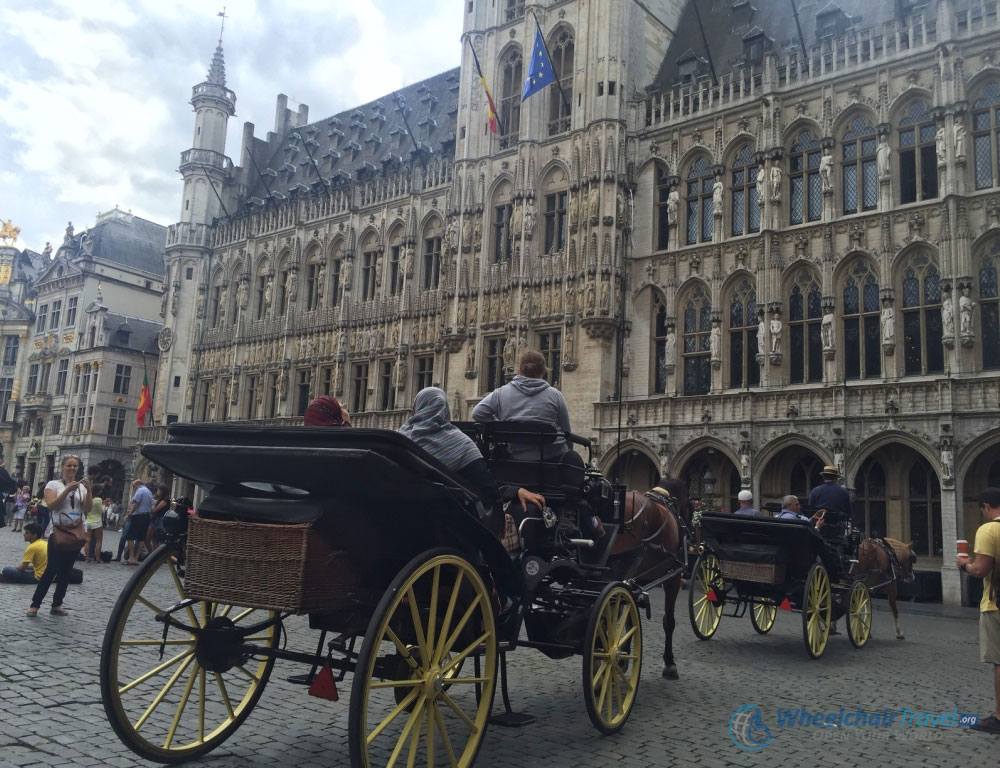
This square is often thought to be the most beautiful in Europe, and perhaps the world. Six pedestrian streets converge in the square, which measures 223 by 361 feet. It is surrounded by beautiful, centuries-old guild houses, the Town Hall and the Museum of the City of Brussels. There are also several shops, restaurants and a chocolatier located on the square.
Unfortunately, wheelchair access in this area of the city is very challenging. Tours of the Town Hall and City Museum are not possible – steps are present at the entrances and there are no elevators within. The Grand Place is paved with cobblestone that will make for an incredibly rough wheelchair roll. But the pictures, sights and atmosphere you’ll experience in the square will ultimately be worth the trouble of it all – I promise! Several other sights are located in the area, along with plenty of restaurants and shops to explore. Only a few blocks away is the famous statue, Manneken Pis. For the coffee or frappucino addict, a Starbucks is located on the square, with outdoor seating accessible to wheelchairs. Numerous restaurants are also located here and are accessible as well.
Manneken Pis
“Little Man Pee,” or Manneken Pis, is a two foot tall bronze statue of a boy urinating into a fountain. The statue was installed at the intersection of Rue de l’Étuve/Stoofstraat and Rue du Chêne/Eikstraat, just a short walk away from Grand Place, in 1618 or 1619.
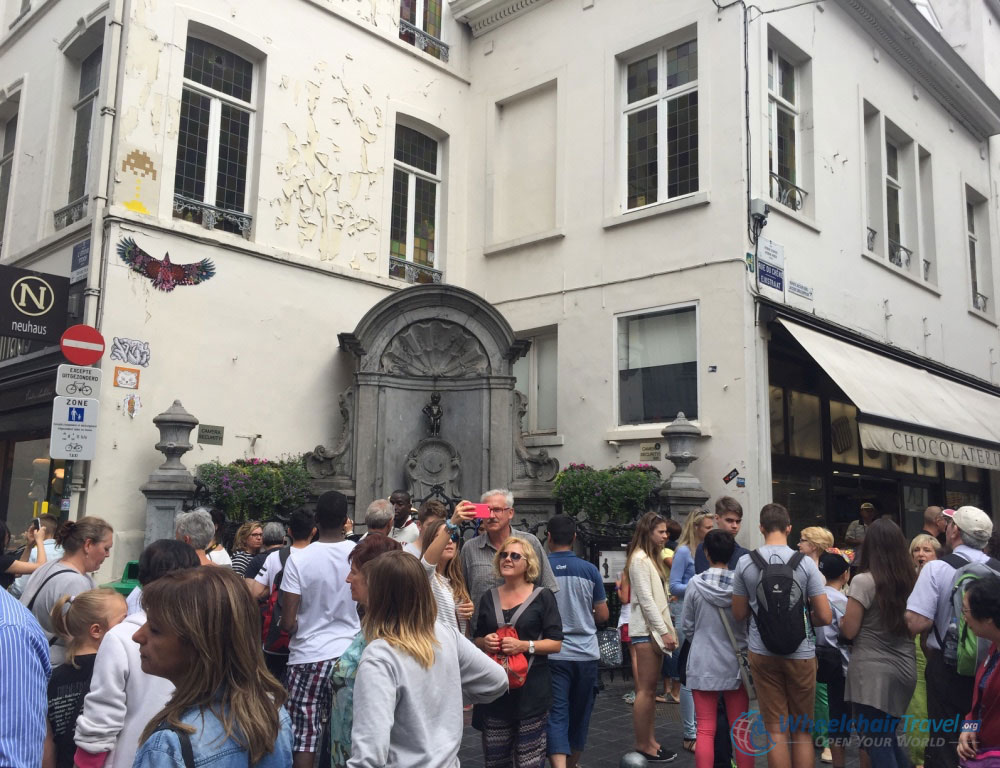
Numerous legends have formed to explain the statue and its prominence. The most popular of these holds that Manneken Pis is a representation of Godfrey III, Count of Louven. At two years of age, it is said that he urinated on troops of the lords of Grimbergen, who were fighting to become independent of his dukedom. The statue today attracts large numbers of tourists. The surrounding streets are filled with shops, restaurants, bars, coffee shops, waffle houses and chocolatiers. While not all of these businesses offer step-free access, many do.
Mont des Arts
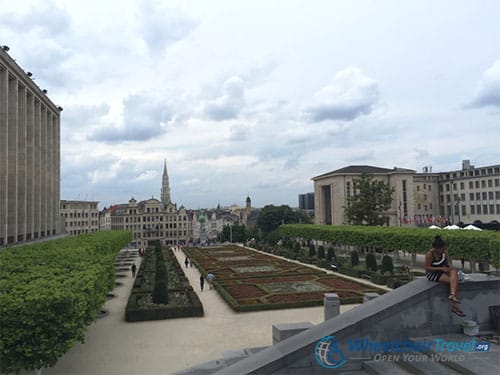
The Kunstberg, or “Hill/Mount of the Arts,” is an elevated embankment in downtown Brussels. It features a small, but well-manicured garden originally constructed for the 1910 Universal Exposition. The Mont des Arts is located halfway down the hill separating the Place Royale and Grand Place, making it an excellent vantage point to see the city below. The spire that sits atop the Town Hall can be seen every day, but in clear weather, views extend as far away as the Atomium in the Heysel neighborhood. All three “levels” of the Mont des Arts can be accessed by wheelchair. The street running alongside the garden is very steep, though. Manual wheelchair users will be need some help climbing the hill. Rolling down from the top of the city to the Grand Place below is best, and public transportation or taxis can be used to reach the top.
Place Royale
The Place Royale, or Royal Square, is a historic square in the center of Brussels. From the square, it is approximately a 10 minute walk/roll down to the Mont des Arts. At the center of the square sits the Saint Jacques-sur-Coudenberg, the Roman Catholic Church of St. James.
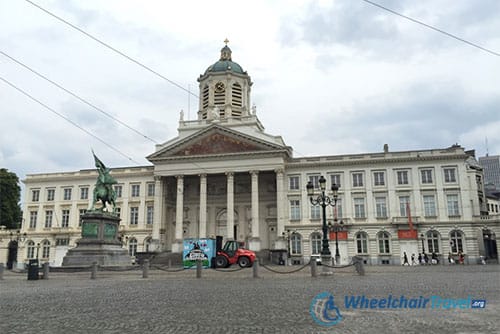
The Church and square were developed from 1773 to 1780, after a fire destroyed the palace that had previously stood there. St. James is considered to be the “Royal Parish,” having played an important role in the modern history of the nation and its monarchy. In 1831, King Leopold I took the oath to the constitution in the square. The Church served as the place of Baptism for King Leopold II, King Albert I, King Leopold III, King Baudouin, King Albert II and King Philip. The church is also the Cathedral for the diocese or Military Ordinariate of the Belgian Armed Forces. The position of Military Ordinary is vested in the Archbishop of Mechelen-Brussels. Unfortunately, due to the church’s age and the steps leading to its sanctuary, the building is not wheelchair accessible. Families and friends may be able to help lift manual wheelchairs up the staircase, but there is no option for powered wheelchairs to gain access.
Cathedral of St. Michael and St. Gudula
The Cathedral of St. Michael and St. Gudula is a Roman Catholic Church, often considered to be the “city’s church.” The cathedral’s patron saints match those of the City of Brussels.
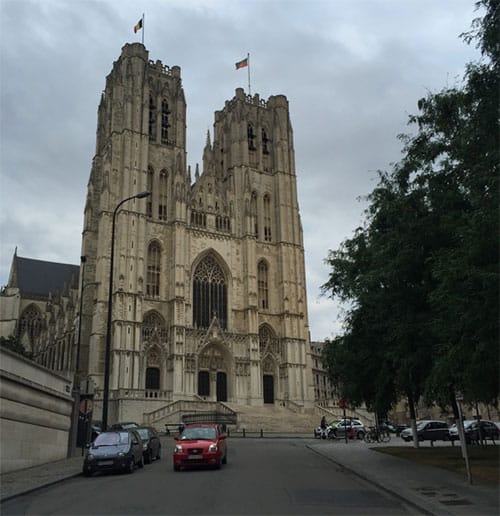
Construction of the present church, which sits on Treurenberg hill, began in 1226 on the instruction of Henry II, Duke of Brabant. The church was not completed until 1519, nearly 300 years after the first stone was laid. It measures 210 feet tall and is built according to the French Gothic style. Its two towers were designed by Flemish architect Jan Van Ruysbroeck, who also designed the tower of the Town Hall, located within Grand Place. The church was raised to cathedral status in 1962, and is the Co-Cathedral of the Archdiocese of Mechelen-Brussels.
The Cathedral’s interior can be accessed by wheelchair through the gift shop located on the right side of the church. From the street, Place Sainte-Gudule, wheelchair users can access a cobblestone sidewalk that runs alongside the church and the accessible, step-free gift shop entrance. The curb separating the sidewalk from the street is rather high in some areas, but is only 2 inches at the church’s midpoint. Although the cobblestone sidewalk is extremely bumpy, it will allow wheelchairs to access the terrace that sits atop the stairway leading from the street to the cathedral. The view here is nice, but not as picturesque as the Mont des Arts. Inside the Cathedral, ramps provide barrier-free access to the sanctuary.
Musical Instruments Museum
Located less than a block away from the Mont des Arts, the Brussels Musical Instruments Museum is a part of the Royal Museums of Art and History. The museum is housed inside the former Old England department store building, constructed in 1899. Its collection includes more than 8,000 musical instruments, making it one of the world’s most impressive museums dedicated to the art and history of music. The museum’s collection is uniquely inspired, as Brussels was the home of instrument inventor Adolphe Sax. The museum, its exhibits and attached restaurant are all fully accessible to wheelchairs. Discounted admission of €2,00 is available to visitors with disabilities. Additional information is available at www.mim.be.
Atomium
The Atomium was the focal point of the 1958 World’s Fair in Brussels, commonly referred to as Expo 58. The Atomium was designed to represent “the democratic will to maintain peace among all the nations, faith in progress, both technical and scientific and, finally, an optimistic vision of the future of a modern, new, super-technological world for a better life for mankind.” The design was modeled after the elementary structure of Iron and celebrated the transition a use of atomic energy for good, rather than war. Although the structure was never intended to remain after the World’s Fair, Belgians soon fell in love with it. Today, it is a landmark and one of the most visited attractions in Brussels.
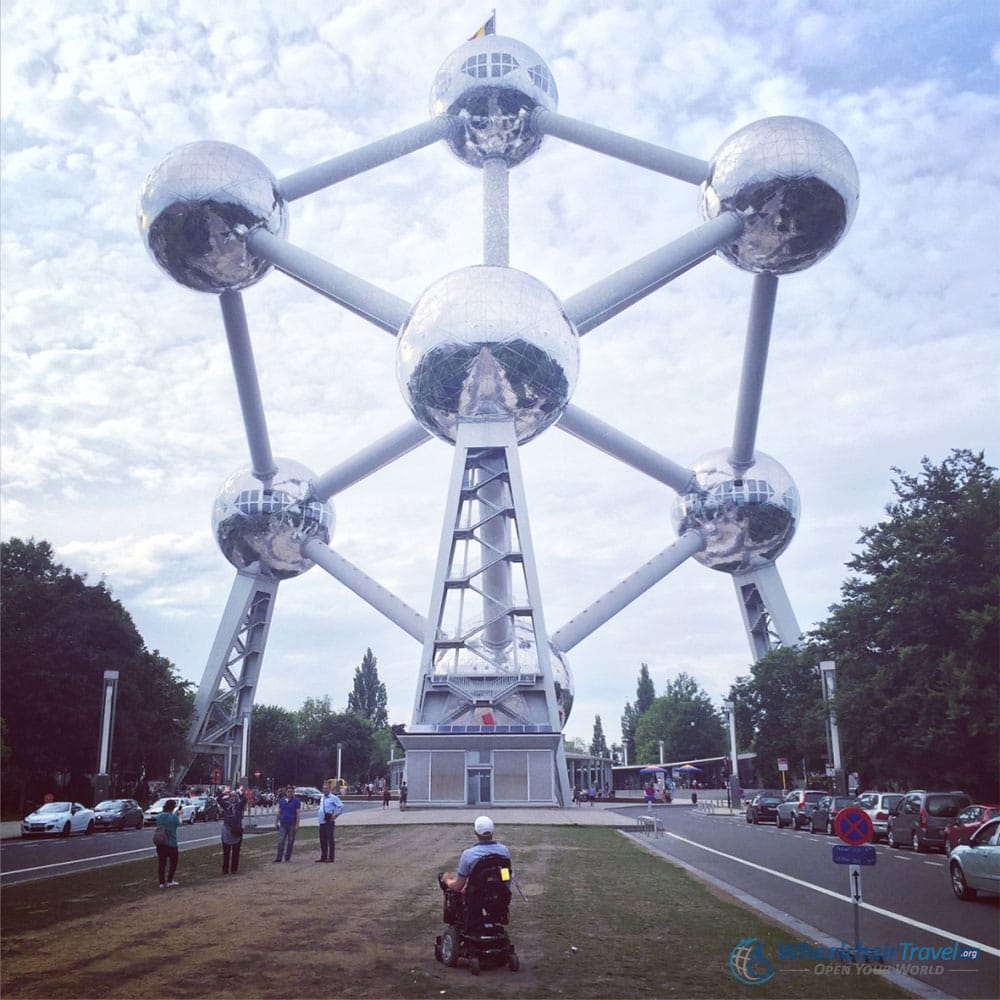
Wheelchair access inside the Atomium is very limited. Each of the spheres hold an exhibition, with the uppermost featuring an observation deck. The observation level is accessed by elevator. This is the only sphere that is wheelchair accessible. The views of the city are excellent on a clear day, but are certainly hampered by the Atomium’s distance from downtown Brussels. All of the other spheres must be accessed by escalator. Wheelchairs and strollers are not allowed on any level, except within the observation sphere. Visitors in wheelchairs receive free admissions. All other persons with disabilities must present a disability ID card to receive complimentary admission. For more information on the Atomium experience, visit www.atomium.be.
Mini-Europe
Located at the foot of the Atomium, Mini-Europe is a premier miniature park that allows visitors to experience all of Europe in just a few short hours. Opened in 1989, Mini-Europe is now home to 350 scale models of buildings and structures from more than 80 European cities.
The models are built with immaculate detail, to 1/25 scale. Many of the models, including that of Mount Vesuvius, are animated and interactive. The park is wheelchair accessible, with sidewalks throughout the grounds. Admission prices are reasonable, with tickets for adults costing only €14,50. There are no discounts for seniors or persons with disabilities. The Mini-Europe experience is equally accessible to all. More information can be found at www.minieurope.com.
National Basilica of the Sacred Heart
The Basilica of the Sacred Heard in Koekelberg is located in the Northwestern corner of Brussels. King Leopold II laid the cornerstone in 1905, but the church was not completed until 1969. Construction had been interrupted by two World Wars.
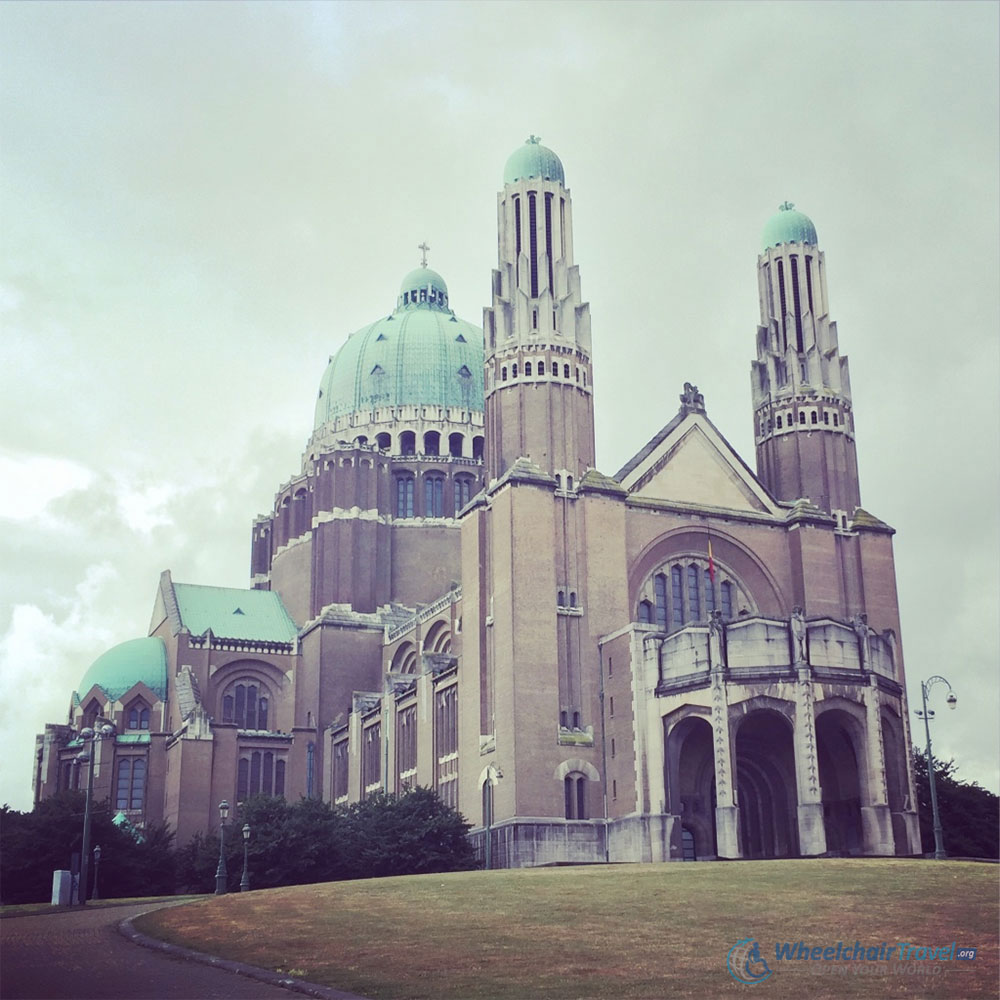
The church building measures 292 feet tall and features two towers that frame a beautiful copper-plated dome. It is the largest building representing the Art Deco style in the world. Big doesn’t end there, though, as the National Basilica is also the 6th largest Roman Catholic Church by area in the world.
Wheelchair accessibility within the Basilica is excellent. The sanctuary, Eucharistic Adoration chapel, side altars and the two museums are all accessible via ramps or elevators. The church also contains an observation deck at the base of its dome, which provides spectacular views of the city from a unique vantage point. This panorama is accessible to wheelchairs via elevator, but bears an admission fee of €5,00. The wheelchair accessible entrance is located at the rear of the church via Door 6. More information, including the Basilica’s schedule of worship services, can be found at www.basilicakoekelberg.be.
Royal Museums of Fine Arts of Belgium
Six museums showcase the Royal art collection of Belgium. These museums are managed by the Royal Museums of Fine Arts of Belgium. The majority are located on the Place Royale, across from the Cathedral Church of St. James. Two of the six museums offer accessibility to wheelchair users. The Fin-de-Siècle Museum is focused primarily on the history of art in Brussels during the 1900s. The Art Nouveau movement is on full display and the collection includes a wide variety of works, from painting and watercolors to architecture and sculpture. The Magritte Museum, dedicated to the works of Rene Magritte, a Belgian Surrealist and one of the world’s most famous artists. The Magritte collection contains more than 200 individual works. Discounted admission is available to persons with disabilities and their guest or attendant. Additional information on the museums, their collections and ticket prices can be found at www.fine-arts-museum.be.
Parlamentarium at the EU Parliament
The headquarters of the European Parliament is located in the EU District of Brussels. The Parlamentarium is the visitors’ center located directly across the courtyard from the parliamentary building in the Espace Leopold complex. The Parlamentarium has a diverse array of exhibits which explain the history, development and expansion of the European Union and its Parliament.
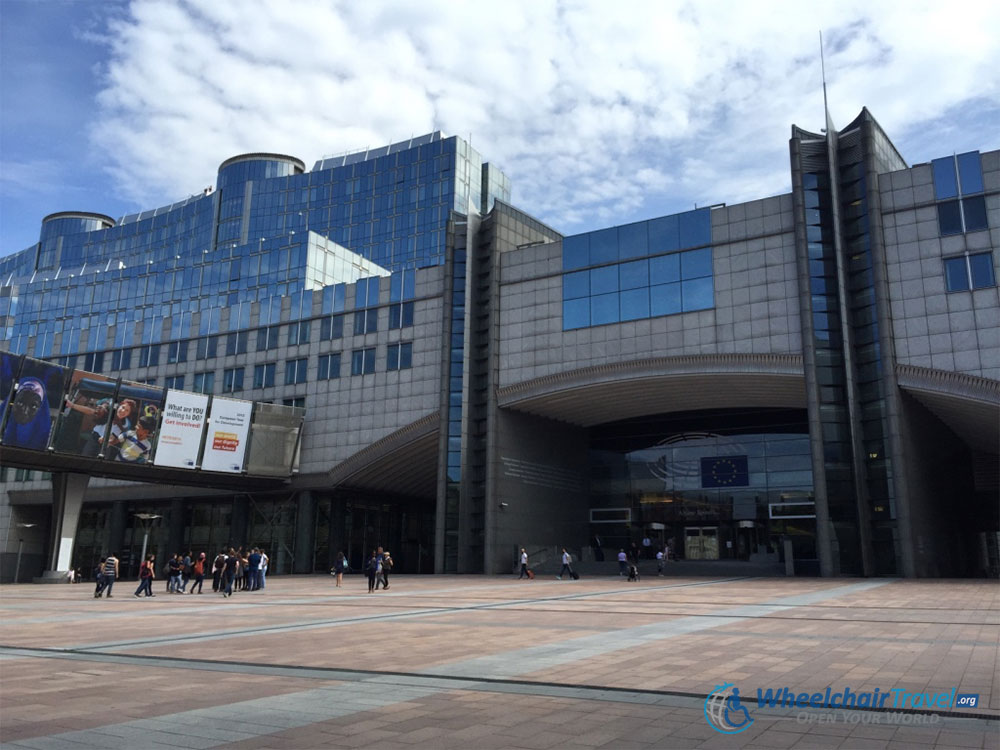
The exhibits rely significantly on multimedia, allowing visitors to take in an incredible amount of information without the constant work of reading. The center was opened to the public in 2011. Audio guides make the information available in all 24 official languages of the EU, including English. Admission is free to all. All exhibits are completely accessible to wheelchair users and accessible restrooms are available onsite. Additional information is available at the Parlamentarium’s official website, www.europarl.europa.eu.



